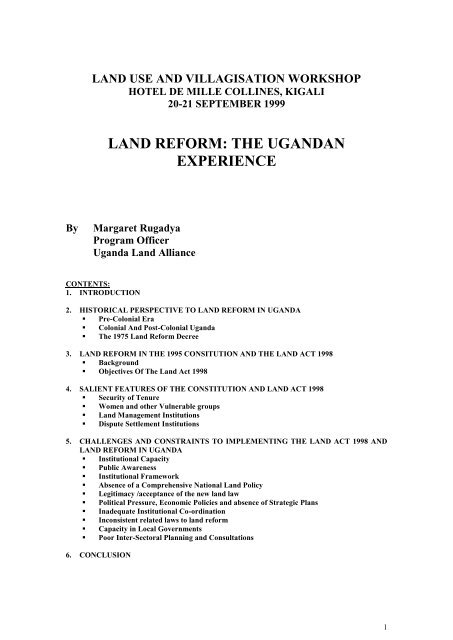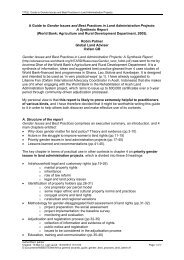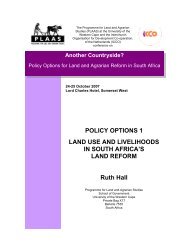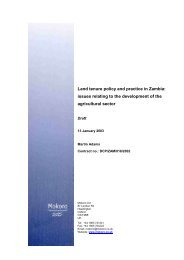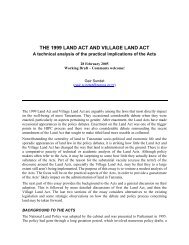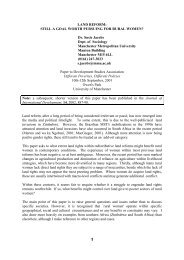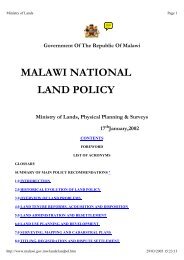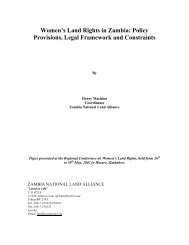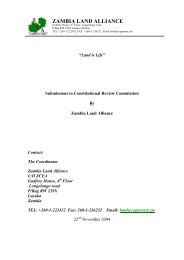Land Reform in Uganda: Problems and Challenges - Mokoro
Land Reform in Uganda: Problems and Challenges - Mokoro
Land Reform in Uganda: Problems and Challenges - Mokoro
You also want an ePaper? Increase the reach of your titles
YUMPU automatically turns print PDFs into web optimized ePapers that Google loves.
devolution of authority over l<strong>and</strong> management/ adm<strong>in</strong>istration as provided for<strong>in</strong> the 1995 Constitution• To ensure proper plann<strong>in</strong>g <strong>and</strong> well-co-ord<strong>in</strong>ated development of urban areas• To ensure susta<strong>in</strong>able l<strong>and</strong> use <strong>and</strong> development throughout the country toconserve the environment• To redress historical imbalances <strong>and</strong> <strong>in</strong>justices <strong>in</strong> the ownership <strong>and</strong> control ofl<strong>and</strong>• To provide for government <strong>and</strong> local government to acquire l<strong>and</strong> compulsorily<strong>in</strong> the public <strong>in</strong>terest <strong>and</strong> public use, public safety, public order, publicmorality or public health.SALIENT FEATURES OF THE CONSTITUTION AND LAND ACT 1998 Security of Tenure1. <strong>L<strong>and</strong></strong> OwnershipArticle 237 of the constitution provides that l<strong>and</strong> <strong>in</strong> <strong>Ug<strong>and</strong>a</strong> shall belong to the citizensof <strong>Ug<strong>and</strong>a</strong> <strong>and</strong> shall vest <strong>in</strong> them <strong>in</strong> accordance with four tenure systems: Customary,Freehold, Mailo <strong>and</strong> Leasehold. This provision is re-enacted <strong>in</strong> section 3 of the <strong>L<strong>and</strong></strong>Act. This clause totally reverses the old system where l<strong>and</strong> was vested <strong>in</strong> the publicl<strong>and</strong>. Now, <strong>in</strong>dividuals’ rights to l<strong>and</strong> have been secured by virtue of occupation.The state no longer controls ownership of l<strong>and</strong> <strong>in</strong> <strong>Ug<strong>and</strong>a</strong>.2. Customary OwnershipArticle 237 (4) (a) of the constitution recognises customary tenure as one of the formsof hold<strong>in</strong>g l<strong>and</strong> <strong>in</strong> <strong>Ug<strong>and</strong>a</strong>. The majority of <strong>Ug<strong>and</strong>a</strong>ns hold l<strong>and</strong> under customarytenure; this provision therefore guarantees them security of l<strong>and</strong> ownership. Thesetenants on customary l<strong>and</strong> can now acquire a certificate of customary ownership on thel<strong>and</strong> they occupy <strong>and</strong> they can convert this certificate to a freehold title. Thiscertificate of customary ownership has been accorded value under the <strong>L<strong>and</strong></strong> Actenabl<strong>in</strong>g it to be transferred, mortgaged, or otherwise pledged. This will enableholders of a certificate of customary ownership to have access to credit.3. Tenants on Registered <strong>L<strong>and</strong></strong>The constitution guarantees security of tenure to tenants on registered l<strong>and</strong> commonlyreferred to as lawful or bonafide occupants. These tenants can acquire a certificate ofoccupancy on the l<strong>and</strong> they occupy <strong>and</strong> if they so wish, they can negotiate with theregistered owner to be able to acquire a freehold title. These tenants on registered l<strong>and</strong>are to pay the registered owner of l<strong>and</strong> a ground rent of not more than 1,000/=. Failureto do this for two (2) consecutive years may lead the tenant to lose his security if he/shedoes not have sufficient reason for not pay<strong>in</strong>g. The registered owner cannot ask thetenants for anyth<strong>in</strong>g else (<strong>in</strong>clud<strong>in</strong>g th<strong>in</strong>gs <strong>in</strong> k<strong>in</strong>d) except that 1,000/= provided for thecertificate of occupancy can also be mortgaged, pledged or transferred. The tenant byoccupancy also has the right to pass on his tenancy <strong>in</strong> a will.4. Communal l<strong>and</strong> OwnershipThe <strong>L<strong>and</strong></strong> Act recognises the right of people to hold communal l<strong>and</strong>. The people mayif they so wish form themselves <strong>in</strong>to a communal l<strong>and</strong> association <strong>and</strong> this association6
may be <strong>in</strong>corporated. The communal l<strong>and</strong> Association may also form a common l<strong>and</strong>management scheme by which the members agree to manage the communal l<strong>and</strong> <strong>and</strong> toset out their rights <strong>and</strong> duties. Women <strong>and</strong> other Vulnerable groupsThe <strong>L<strong>and</strong></strong> Act <strong>in</strong> S.40 requires that before any transaction can be carried out on l<strong>and</strong> onwhich a family resides or from which it derives a sustenance, the spouse, dependentchildren of majority age <strong>and</strong> the <strong>L<strong>and</strong></strong> Committee <strong>in</strong> case of children under the age ofmajority should be consulted. The <strong>L<strong>and</strong></strong> Act also provides <strong>in</strong> accordance withconstitutional provisions, that any customary provisions, that any customary practiceswhich deny women, children or use of any l<strong>and</strong> shall be null <strong>and</strong> void. The <strong>L<strong>and</strong></strong>Committees have the duty of ensur<strong>in</strong>g that the rights of vulnerable groups are protected. <strong>L<strong>and</strong></strong> Management InstitutionsThe <strong>L<strong>and</strong></strong> Act <strong>in</strong> pursuance of the overall government policy of decentralisation hasdecentralised l<strong>and</strong> management <strong>and</strong> dispute settlement mechanism. The legislationrequires the creation of a very large number of new <strong>in</strong>stitutions for l<strong>and</strong>management/adm<strong>in</strong>istration <strong>and</strong> l<strong>and</strong> dispute resolution. These have been designed toshift the focus of l<strong>and</strong> management to the local level, <strong>and</strong> provide for effectivecommunity <strong>in</strong>volvement <strong>in</strong> l<strong>and</strong> management decisions.The <strong>L<strong>and</strong></strong> Management hierarchy starts with the <strong>Ug<strong>and</strong>a</strong> <strong>L<strong>and</strong></strong> Commission, whichshall be responsible for any government l<strong>and</strong> <strong>and</strong> related issues. The District l<strong>and</strong>boards <strong>in</strong>dependent from the <strong>Ug<strong>and</strong>a</strong> <strong>L<strong>and</strong></strong> Commission <strong>and</strong> from any othergovernment organ or person are <strong>in</strong> charge of all l<strong>and</strong> <strong>in</strong> the district. The l<strong>and</strong>committees set up <strong>in</strong> each parish gazetted urban area or a division <strong>in</strong> the case ofKampala as advisory role to the District <strong>L<strong>and</strong></strong> Board. At one of the plann<strong>in</strong>gworkshops, a simple rough count was taken <strong>and</strong> the follow<strong>in</strong>g figures reflect thenumber of officers <strong>and</strong> the amount of manpower needed to make the Act operational:Institution No. of Officials TotalOfficesDistrict <strong>L<strong>and</strong></strong> Boards 45 5 225<strong>L<strong>and</strong></strong> Committees 7000 4 28000Recorders 917 1 917District <strong>L<strong>and</strong></strong> Offices 45 5 225District <strong>L<strong>and</strong></strong> Tribunals 45 3 135Sub-county <strong>L<strong>and</strong></strong> 917 3 2751Tribunals Dispute Settlement InstitutionsThe <strong>L<strong>and</strong></strong> Act provides that effective July 2 nd when the <strong>L<strong>and</strong></strong> Act was passed as law, allLC courts <strong>and</strong> magistrate courts stop h<strong>and</strong>l<strong>in</strong>g new l<strong>and</strong> matters <strong>and</strong> only complete oldcases with<strong>in</strong> the next two years. There shall be a l<strong>and</strong> tribunal for each district,sub-county <strong>and</strong> for each gazetted urban area <strong>and</strong> <strong>in</strong> the case of a city, a tribunal for eachdivision. The chief justice will appo<strong>in</strong>t the Judicial Service Commission will appo<strong>in</strong>tthe District <strong>L<strong>and</strong></strong> Tribunals <strong>and</strong> the sub-county <strong>and</strong> urban l<strong>and</strong> tribunals. The <strong>L<strong>and</strong></strong> Act7
provides for several issues <strong>in</strong> other sections but the above represent the salient issues <strong>in</strong>brief.CHALLENGES AND CONSTRAINTS TO IMPLEMENTING THE LAND ACT1998 AND LAND REFORM IN UGANDA1. Institutional capacity <strong>and</strong> adm<strong>in</strong>istrationIn implement<strong>in</strong>g the <strong>L<strong>and</strong></strong> Act, the M<strong>in</strong>istry of Water, <strong>L<strong>and</strong></strong>s <strong>and</strong> Environment(MWLE) which is the l<strong>in</strong>e m<strong>in</strong>istry, has adopted a participatory <strong>and</strong> consultativeapproach to the plann<strong>in</strong>g as well as the actual execution of the implementation by<strong>in</strong>volv<strong>in</strong>g all key stakeholder. The country has adopted a participatory <strong>and</strong> consultativeimplementation strategy. The ma<strong>in</strong> thrust of this strategy is a creative “bottom up”approach to the implementation by <strong>in</strong>volv<strong>in</strong>g a range of stakeholders from the outset,<strong>and</strong> by build<strong>in</strong>g capacity at the centre, <strong>in</strong> local <strong>in</strong>stitutions, <strong>and</strong> at the grass-roots.This is not go<strong>in</strong>g to be easy given <strong>Ug<strong>and</strong>a</strong>’s tradition of top-down adm<strong>in</strong>istration.However, <strong>Ug<strong>and</strong>a</strong> has already made several strides <strong>in</strong> its decentralisation programme.The ma<strong>in</strong> challenge is to balance the need for strong co-ord<strong>in</strong>ation at the centre witheffective mobilisation of district based <strong>in</strong>stitutions to use the powers devolved to themby the <strong>L<strong>and</strong></strong> Act. There is a danger that the centre will attempt to take on too much, orthat local governments <strong>and</strong> other local <strong>in</strong>stitutions will not be empowered enough tofulfil their roles effectively. The latter danger is already a real threat.2. Public Awareness on the <strong>L<strong>and</strong></strong> ActThe urgent provision of <strong>in</strong>formation for the public, as to the content of the Act <strong>and</strong> itsimplications have not been widely publicised, <strong>and</strong> there is a clear dem<strong>and</strong> for<strong>in</strong>formation, as reported by district adm<strong>in</strong>istrations <strong>and</strong> NGO’s. The provision <strong>and</strong>ma<strong>in</strong>tenance of grassroots support for l<strong>and</strong> tenure reform is a critical element <strong>in</strong> thesuccess of implementation. Government has therefore to give high priority tosensitisation i.e. lett<strong>in</strong>g each <strong>and</strong> every citizen know what the new l<strong>and</strong> law says, whatit does not say, what roles it plays <strong>in</strong> l<strong>and</strong> reform, what is go<strong>in</strong>g to change <strong>and</strong> how,what k<strong>in</strong>d of time frame may the stake holders expect, <strong>and</strong> what the law means for thedifferent stakeholders.To this end, a Sensitisation Focus Group has been established composed ofgovernment, non-government <strong>and</strong> private media persons to oversee the production <strong>and</strong>dissem<strong>in</strong>ation of <strong>in</strong>formation messages to the grassroots. In the mean time only the<strong>Ug<strong>and</strong>a</strong> <strong>L<strong>and</strong></strong> Alliance has made efforts to reach people at the grassroots levels on asmall scale (10 districts out of the 45) <strong>and</strong> the response has been overwhelm<strong>in</strong>g.3. Institutional FrameworkThe establishment of District <strong>L<strong>and</strong></strong> Boards by 2 nd January 1999 <strong>and</strong> the <strong>L<strong>and</strong></strong> Fund by2 nd July 1999, are requirements under the Act. By 18 th January 1999 only 18 District<strong>L<strong>and</strong></strong> Boards out of a total or 45 had been appo<strong>in</strong>ted. The laid down procedure iscomplex as these boards are appo<strong>in</strong>ted with the approval of the M<strong>in</strong>ister.8
Under the <strong>L<strong>and</strong></strong> Act, with effect from 2 nd July, 1998 jurisdiction over l<strong>and</strong> disputespassed from Local Council <strong>and</strong> Magistrate’s Courts to a system of <strong>L<strong>and</strong></strong> Tribunals to beestablished. Until these tribunals are appo<strong>in</strong>ted <strong>and</strong> rendered operational there is aserious vacuum <strong>in</strong> l<strong>and</strong> dispute settlement. No concrete efforts have taken place <strong>in</strong> thisarea as yetThe biggest challenge to implementation is the putt<strong>in</strong>g <strong>in</strong> place of the many new<strong>in</strong>stitutions, which are created by the Act <strong>and</strong> operationalis<strong>in</strong>g the <strong>in</strong>stitutions. Thebiggest question is whether the exist<strong>in</strong>g <strong>in</strong>stitutions <strong>and</strong> agencies have adequatecapacity to undertake implementation activities <strong>and</strong> to produce the expected results.Equally challeng<strong>in</strong>g is how to co-ord<strong>in</strong>ate the very large number of <strong>in</strong>stitutions, whichare <strong>in</strong>volved <strong>in</strong> l<strong>and</strong> matters. MWLE is responsible for the creation of proceduralframeworks, guidance <strong>and</strong> methodologies, <strong>and</strong> for capacity build<strong>in</strong>g <strong>and</strong> <strong>in</strong>spectionfunctions. Local governments are themselves directly m<strong>and</strong>ated to establish <strong>and</strong>support the local level management structures.The Directorate of <strong>L<strong>and</strong></strong> <strong>and</strong> Environment has the overall responsibility to oversee theimplementation of the <strong>L<strong>and</strong></strong> Act. The M<strong>in</strong>istry has a number of experienced,well-tra<strong>in</strong>ed professional staff but its overall capacity to h<strong>and</strong>le the dem<strong>and</strong>s of the newl<strong>and</strong> law is low. Under the current civil service recruitment freeze, there is very littlechance of <strong>in</strong>creas<strong>in</strong>g staff<strong>in</strong>g levels. Overall there are major capacity constra<strong>in</strong>ts, both<strong>in</strong> terms of the resources <strong>and</strong> expertise at the disposal of exist<strong>in</strong>g <strong>in</strong>stitutions, <strong>and</strong> theability to resource <strong>and</strong> fund the new <strong>in</strong>stitutions.4. Absence of a comprehensive national l<strong>and</strong> policy<strong>Ug<strong>and</strong>a</strong> lacks a comprehensive national l<strong>and</strong> policy, which is so vital <strong>in</strong> guid<strong>in</strong>gimplementation of the l<strong>and</strong> law. What exists are scattered part of the policy which canonly be pieced together from the 1995 Constitution, presidential publicpronouncements <strong>and</strong> government statements. The need for a clear <strong>and</strong> comprehensivenational l<strong>and</strong> policy to guide the provisions <strong>in</strong> the l<strong>and</strong> law, streaml<strong>in</strong>e the objectives<strong>and</strong> guard aga<strong>in</strong>st contradictions <strong>and</strong> <strong>in</strong>consistencies cannot be under estimated. Anational l<strong>and</strong> policy is also necessary to guide <strong>in</strong>stitutional implementers on how toexercise the discretionary powers, which the new law bestows on them. The policywould also guide <strong>in</strong> the prioritisation of objectives as well as the implementationactivities5. Legitimacy/Acceptance of the new lawFrom day one, the <strong>L<strong>and</strong></strong> Bill was received with suspicion, apathy, fear <strong>and</strong> outrightrejection <strong>in</strong> some quarters. The Report of the Parliamentary Sessional Committee onthe <strong>L<strong>and</strong></strong> Bill has this to say:“From our own experiences dur<strong>in</strong>g the public consultations we held, it wasapparent that people’s <strong>in</strong>dignation with the Bill was because of their ignoranceof its contents <strong>and</strong> what it aims to achieve... it is therefore important that thegovernment should, before <strong>in</strong>troduc<strong>in</strong>g any law, make widespread consultationswith the people <strong>and</strong> get their trust. As one em<strong>in</strong>ent lawyer said, if you don’ttrust the messenger why should you trust the message.”9
Many sections feel that the <strong>L<strong>and</strong></strong> Bill was not given adequate time to be considered,scrut<strong>in</strong>ised <strong>and</strong> debated as because it was published very late on 2 nd March, 1998 whiletarget<strong>in</strong>g it to make it law by 1 st July, 1998. The majority of mailo owners especially <strong>in</strong>Bug<strong>and</strong>a are also not happy about the new status given to the bonafide occupants by thelaw. It is likely that some groups of primary stakeholders whose <strong>in</strong>terests are threatenedby the legislation may try to overturn the legislation or parts of it, by tabl<strong>in</strong>gamendments <strong>in</strong> parliament, recourse to the Constitutional Court, or by caus<strong>in</strong>g civildisturbances.The women are not happy because the clause on co-ownership of l<strong>and</strong> by spouses forwhich NGO’s especially the <strong>Ug<strong>and</strong>a</strong> <strong>L<strong>and</strong></strong> Alliance, FIDA <strong>and</strong> UWONET lobbied somuch for was accepted <strong>in</strong> pr<strong>in</strong>ciple by Parliament, but was miss<strong>in</strong>g from the Act.Arrangements are underway by the government to ensure that it returns to parliament, itdraft is already out6. Political Pressure, Economic Policies <strong>and</strong> absence of strategic planPartly as a counterweight to the vocal opposition <strong>in</strong> the country, <strong>and</strong> as a response topopular expectations, there is currently a lot of political pressure to be seen to beimplement<strong>in</strong>g the <strong>L<strong>and</strong></strong> Act, this could underm<strong>in</strong>e the implementation process ifgovernment takes to hasty <strong>and</strong> ill-advised actions. There have be dem<strong>and</strong>s frompolitical quarters that the law is implemented immediately.Over reliance on market-assisted approaches <strong>and</strong> dem<strong>and</strong>-driven solutions, throughoutthe <strong>L<strong>and</strong></strong> Act market-assisted approaches <strong>and</strong> dem<strong>and</strong>-driven strategies underp<strong>in</strong> thereform programme. The biggest question to ask is whether these approaches willdeliver on the objectives of the <strong>L<strong>and</strong></strong> Act.One of the serious weaknesses <strong>in</strong> the reform programme is that there was no strategicplan at the <strong>in</strong>ception of the <strong>L<strong>and</strong></strong> Bill to work out the required resources, the f<strong>in</strong>ancialimplications, <strong>and</strong> the availability of human <strong>and</strong> f<strong>in</strong>ancial resources. Severalimplementation studies have been carried out under the auspices of DFID <strong>in</strong>dicate that<strong>in</strong> it’s present form the <strong>L<strong>and</strong></strong> Act is not implementable <strong>and</strong> the responsible M<strong>in</strong>istry hasto move the necessary amendments if it to be implemented at all.7. Inadequate <strong>in</strong>stitutional co-ord<strong>in</strong>ationThe success of implementation will depend on the effective co-ord<strong>in</strong>ation <strong>and</strong>contributions of a wide range of <strong>in</strong>stitutional stakeholders <strong>in</strong>clud<strong>in</strong>g non-governmentorganisations, <strong>and</strong> the commitment of a large range of key actors. There is a risk thatcerta<strong>in</strong> key legal requirements for the establishment of <strong>in</strong>stitutions will be delayed bybureaucratic <strong>in</strong>efficiencies. In particular authoritative decisions will be required onpo<strong>in</strong>ts of law relat<strong>in</strong>g to the <strong>L<strong>and</strong></strong> Fund <strong>and</strong> the l<strong>and</strong> Tribunals before realistic plans canbe made for its management <strong>and</strong> operations, <strong>and</strong> parliamentary assent will be requiredfor the authorisation of regulations govern<strong>in</strong>g the operations of <strong>in</strong>stitutions.The constitutional <strong>and</strong> legislative framework with<strong>in</strong> which the key <strong>in</strong>stitutions mustoperate is somewhat ambiguous, especially <strong>in</strong> terms of the boundaries of their variousm<strong>and</strong>ates. There is already a big issue on implications of the autonomy/<strong>in</strong>dependenceof District <strong>L<strong>and</strong></strong> Boards. How much power do District Authorities have <strong>in</strong> determ<strong>in</strong><strong>in</strong>g10
l<strong>and</strong> policy <strong>and</strong> <strong>in</strong> regulat<strong>in</strong>g <strong>in</strong> its respect through promulgation of by-laws? How does<strong>Ug<strong>and</strong>a</strong> make devolution real on the ground when the 1995 Constitution lists l<strong>and</strong> as anational function? Section 94 of the <strong>L<strong>and</strong></strong> Act gives power of mak<strong>in</strong>g regulations tothe M<strong>in</strong>ister responsible for l<strong>and</strong>s, with the approval of Parliament. Gett<strong>in</strong>g thebalance right between help<strong>in</strong>g the districts do the job well <strong>and</strong> prescrib<strong>in</strong>g how they doit, is one of the most important challenges fac<strong>in</strong>g government. It is imperative that thekey statutory bodies <strong>and</strong> other stakeholders have a serious dialogue to sort out issues.In this way duplication of effort, conflict<strong>in</strong>g priorities <strong>and</strong> confused <strong>in</strong>formation can beavoided, <strong>and</strong> the effective implementation of the legislation secured.8. Inconsistent related lawsA number of other l<strong>and</strong>-related laws are <strong>in</strong> need of review <strong>and</strong> up-dat<strong>in</strong>g <strong>in</strong> order toharmonise them with the provisions of the Constitution <strong>and</strong> <strong>L<strong>and</strong></strong> Act <strong>and</strong> to meetcurrent needs. The pr<strong>in</strong>cipal laws which are <strong>in</strong> need of revision are the Survey Act(which dates from the 1920s <strong>and</strong> provides for detailed <strong>and</strong> high st<strong>and</strong>ard cadastralsurvey which is unnecessary complicated for survey<strong>in</strong>g of customary hold<strong>in</strong>gs), theRegistration of Titles Act (which is currently based on the Torrens system ofregistration, sett<strong>in</strong>g out lengthy <strong>and</strong> difficult procedures for the acquisition ofcertificates of titles), the <strong>L<strong>and</strong></strong> Acquisition Act (which is currently <strong>in</strong>consistent withConstitutional requirements for compensation for l<strong>and</strong> acquired by government <strong>and</strong>could cause difficulties <strong>in</strong> acquir<strong>in</strong>g l<strong>and</strong> for redistribution to tenants), the MortgageDecree (which is at present virtually <strong>in</strong>operable <strong>and</strong> would make the provision of loansfrom the <strong>L<strong>and</strong></strong> Fund along <strong>and</strong> difficult process, <strong>and</strong> also the use of certificates ofcustomary ownership <strong>and</strong> certificates of customary occupancy as security for creditimpossible), <strong>and</strong> the Town <strong>and</strong> Country Plann<strong>in</strong>g Act (which needs harmonisation withthe current local government arrangements)9. Capacity <strong>in</strong> local governmentsThe heaviest burden of implementation lies with the local governments. These localgovernments have serious capacity short falls. Districts are likely to be unable torecruit qualified technical staff for District <strong>L<strong>and</strong></strong> Offices <strong>and</strong> therefore unable toperform adequately the support services necessary for many aspects of l<strong>and</strong> reform.The <strong>L<strong>and</strong></strong> Act required each district to have 5 professional staff a <strong>L<strong>and</strong></strong> Officer, aSurveyor, a Registrar of Titles, a Valuer, <strong>and</strong> a Physical Planner. Only 16 districts outof a total of 45 currently have <strong>L<strong>and</strong></strong> Offices; only one of these a Physical Planner, noneof them has a Valuer <strong>and</strong> only a few have District Registrars of Titles. The successfulimplementation requires a well-paid, motivated <strong>and</strong> transparent civil service.Currently the personnel lack tools <strong>and</strong> a liv<strong>in</strong>g wage which factors seriously erode thecapacity to deliver.10. Poor Inter-Sectoral Plann<strong>in</strong>g <strong>and</strong> ConsultationsDifferent l<strong>in</strong>e m<strong>in</strong>istries <strong>and</strong> departments are <strong>in</strong>volved with l<strong>and</strong>, other naturalresources <strong>and</strong> agriculture, all of which have a long tradition of <strong>in</strong>dependent action <strong>and</strong>rarely consult among each other when formulat<strong>in</strong>g policies under their l<strong>in</strong>e sectors. Agood example is the National policy on Modernisation of Agriculture <strong>and</strong> FoodSecurity. Throughout the formulation of this important policy, which depends a lot onl<strong>and</strong> for its success, no senior officer from the l<strong>and</strong> sector was <strong>in</strong>volved. In the end anumber of policies are not properly harmonised. For example the Poverty Eradication11
Action Plan talks very little about the l<strong>and</strong> sector <strong>and</strong> the policy objectives <strong>and</strong> policy<strong>in</strong>struments <strong>in</strong> the plan cover<strong>in</strong>g l<strong>and</strong> are a bit vague. There is need to revamp <strong>and</strong>rationalise the various bureaucracies that have jurisdictions <strong>in</strong> the l<strong>and</strong> sector <strong>and</strong> theagrarian sector with the aim, <strong>in</strong>ter-alia, of elim<strong>in</strong>at<strong>in</strong>g overlaps, conflicts, contradictions<strong>and</strong> <strong>in</strong>ertia.CONCLUSIONThere is opportunity for partnership <strong>in</strong> implement<strong>in</strong>g the <strong>L<strong>and</strong></strong> Act. Government canwork with committed Local Non-Governmental Organisations with activities related tol<strong>and</strong>, agriculture, food security <strong>and</strong> women. A number of these NGO’s have alreadybeen important <strong>in</strong> lobby<strong>in</strong>g on behalf of specific <strong>in</strong>terest groups <strong>in</strong> relation to the l<strong>and</strong>law. Many of these NGO’s have also participated <strong>in</strong> the consultations <strong>and</strong> theirpresence is a great asset. <strong>Ug<strong>and</strong>a</strong> <strong>L<strong>and</strong></strong> Alliance is a consortium of local <strong>and</strong><strong>in</strong>ternational NGO’s set up as pressure group with the mission of ensur<strong>in</strong>g that l<strong>and</strong>policies <strong>and</strong> laws are reviewed to address the l<strong>and</strong> rights of the poor <strong>and</strong> to protectaccess to l<strong>and</strong> for the vulnerable <strong>and</strong> disadvantaged groups <strong>and</strong> <strong>in</strong>dividuals <strong>in</strong> <strong>Ug<strong>and</strong>a</strong>.Groups, <strong>Ug<strong>and</strong>a</strong> Women’s Network (UWONET), <strong>Ug<strong>and</strong>a</strong> Women’s LawyersAssociation (FIDA), <strong>and</strong> <strong>Ug<strong>and</strong>a</strong> National Farmers Association (UNFA). A nationalassociation of farmers with a network of field offices <strong>and</strong> the ability to deliverextension services <strong>and</strong> public <strong>in</strong>formation messages to a broad constituency.At the start of the reform process, it was stated that the most appropriate goals fortenure reform <strong>in</strong> <strong>Ug<strong>and</strong>a</strong> are that the l<strong>and</strong> tenure law <strong>and</strong> practice should contribute tothe economic <strong>and</strong> social development of agriculture, protect the l<strong>and</strong> rights of farmerswho have no alternative source of <strong>in</strong>come <strong>and</strong> contribute to the evolution of a s<strong>in</strong>gleuniform, efficient <strong>and</strong> equitable tenure system for the nation, as to whether the currentreform will achieve these expected results still rema<strong>in</strong>s to be seen.ReferencesMwebaza Rose, <strong>L<strong>and</strong></strong> <strong>Reform</strong> <strong>in</strong> <strong>Ug<strong>and</strong>a</strong>: <strong>Problems</strong> <strong>and</strong> <strong>Challenges</strong>: a paper presentedat a tra<strong>in</strong><strong>in</strong>g of tra<strong>in</strong>er workshop for tribunals, Kampala 19 th April 1999Okoth-Ogendo, H. W. Implement<strong>in</strong>g <strong>L<strong>and</strong></strong> Legislation <strong>in</strong> <strong>Ug<strong>and</strong>a</strong>: draw<strong>in</strong>g onComparative experiences: a presentation at a technical workshop on theimplementation of <strong>Ug<strong>and</strong>a</strong> <strong>L<strong>and</strong></strong> Act J<strong>in</strong>ja, July 1998Ovonji-Odida, Irene, <strong>L<strong>and</strong></strong> Law reform: challenges <strong>and</strong> opportunities for secur<strong>in</strong>gwomen’s l<strong>and</strong> rights <strong>in</strong> <strong>Ug<strong>and</strong>a</strong>. A paper for a delegates workshop on <strong>L<strong>and</strong></strong> TenurePolicy <strong>in</strong> African nations, Engl<strong>and</strong>, 1999.Nsamba-Gayiiya, Eddie. The complexities if implement<strong>in</strong>g <strong>L<strong>and</strong></strong> Tenure <strong>Reform</strong>: tasksahead for <strong>Ug<strong>and</strong>a</strong>. A paper presented at the DFID workshop on l<strong>and</strong> tenure policy <strong>in</strong>Africa, Engl<strong>and</strong> 16-19 February 1999<strong>L<strong>and</strong></strong> Tenure <strong>and</strong> Agricultural Development <strong>in</strong> <strong>Ug<strong>and</strong>a</strong>, Prepared by Makerere Instituteof Social Research <strong>and</strong> the <strong>L<strong>and</strong></strong> Tenure Centre, University of Wiscons<strong>in</strong>, 198912


